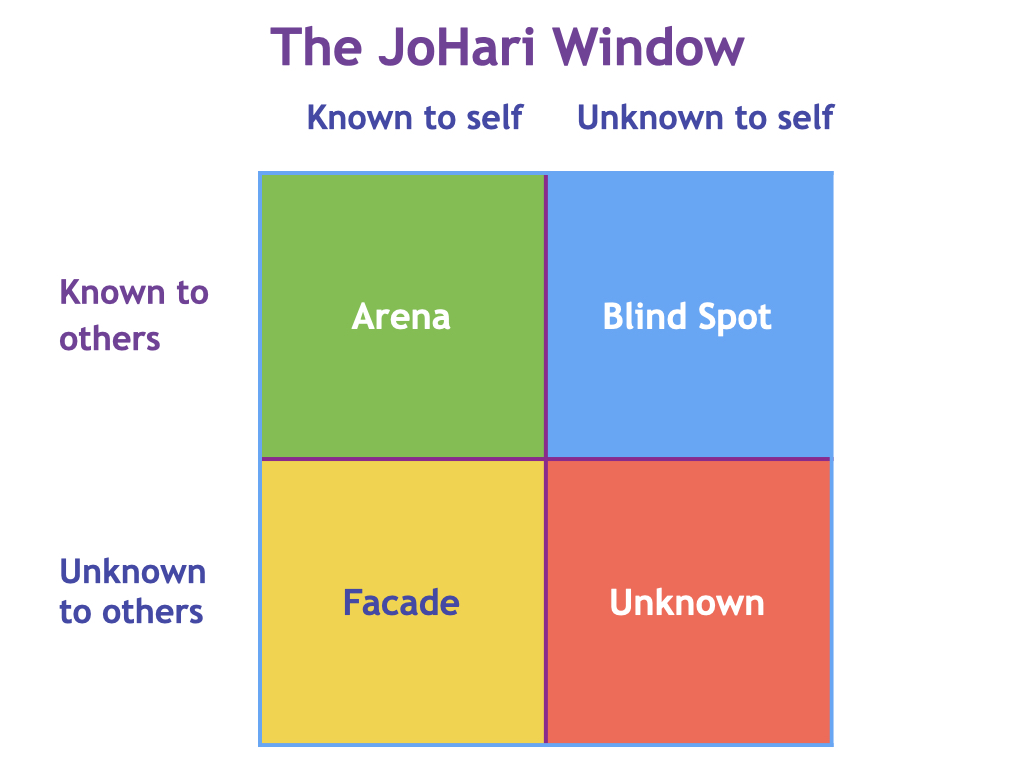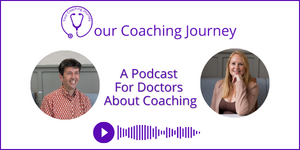Prefer to listen?
This blog post forms the basis of a podcast on our new coaching model, which you can listen to here.
The Johari window was created by two men, one called Joe, one called Harry, who combined their names to be Johari.
It addresses information, and who knows about it.
There are four quadrants containing different types of information:

The Arena:
This is the information that we know about ourselves and that we choose to share with others. For example, how we might describe ourselves, but also how other people would describe us, how we look, how we behave in certain situations, information you might choose to share. If we met someone networking, we might readily share what our business is, what our job role is. If you were entering a new team at work you might share snippets about your personal life, perhaps that you’re married, maybe you have children, but you might not go much further than that, initially, until you get to know people a bit better. You might share some things about your work experience, or a bit about your personality. The more you get to know these people, the more you open up, so the more goes into that arena.
The Façade:
This is the information that we know about ourselves, but we choose not to share with other people. When you enter a new team, you’re trying to make a good first impression, to reassure them that you know what you’re doing, that you’re quite capable, and maybe you don’t share the things you’re not good at, or your weaknesses just yet. They will sit in the façade. If we’re meeting people for the first time, we might not share our opinions of lots of things. Things that you might feel would be contentious might stay in that façade for a while until you understood how everyone else felt. Coming into a team where people already know each other, they might more readily talk about things openly. So there might be more in their arena that they’re sharing with others than you feel willing to do when you first join them. You’re finding out the lay of the land, getting a handle on things, and you’re seeing what it’s safe to share. It could be your opinions of people in the team, or what the culture is like.
Hopefully, if you join a new team, you will have some shared values, there will be the organisational values, if they’ve been communicated, but you’ll have your own values as well, and you might choose not to share them.
When we meet people for the first time, we’re not likely to share things that we’re perhaps feel guilty about, shameful about, so past mistakes could be in this quadrant, alongside really personal information that we don’t want to share. Everyone needs to feel safe. If we give too much away, we might be judged. It might not do our career too much good.
The Blind Spot:
These are the things that we don’t know about ourselves. And other people do know, but they don’t tell us. These are the things that they’ll talk about to other people behind our backs, but just never say to us. Laziness or perceived laziness would sit in that blind spot. It’s the things in the workplace that does get talked about, but no one actually goes and confronts that person and holds them to account for what they’re doing or not doing. It could be just an annoying habit that you have or it t could be skills. If you’re perhaps not particularly competent at a certain procedure that could fit into the blind spot. It’s the things that we just don’t recognise about ourselves, and that could be strengths too, something that everyone else finds hard, so they always ask you to do it, and you never recognised that it was a strength or a skill of yours.
The Unknown Unknowns:
These are the things we don’t know about ourselves and the other people don’t know about us either. The things that would fit in there are areas that we could develop, that we could be good at, but we just don’t know. We’ve not tried it yet. In life, and within organisations, there are all sorts of things that people choose not to do just because they’ve never tried it, so, they don’t know that they’re good at it.
How Could We Use The Johari Window In Coaching?
The Johari Window gives us a different lens to look at ourselves through. It can help with reflection, understanding yourself better, for team dynamics and for relationships.
It can be extremely useful just to make clients aware of this model, particularly if they are working in a team, and maybe they’re having difficulty in understanding why they’re not fitting in or why they’ve got difficulties with certain individuals. Talking through the quadrants and what they represent, then exploring the situation using coaching questions can help deepen a clients awareness and enlighten them as to any actions that need to be taken, or questions that need to be asked.
Sometimes it is just talking about expanding that arena to get to know more about other people, but also to share more about yourself. And then the expansion of that arena generally helps people to come together as a team.
Reflection:
We could use this model with our clients to prompt reflection and to really explore, know, and understand themselves better.
For example, reflection on the situation or a skillset using the four quadrants to prompt coaching questions:
What do I know that other people also know?
What do I know that other people don’t know?
Understanding Yourself Better:
Asking for feedback from others, or being observed and receiving feedback, for example, as a coach, can help explore the blind spot.
On a personal level, doing the work to increase their awareness of themselves and to understand different psychological, emotional concepts in a way that then allows them to articulate that to other people can be really helpful. If they suddenly find out they are an introvert, it’s so helpful to be able to say to the team that the reason they do X is because they have an introversion preference. Then suddenly everyone else understands it. It’s no longer the blind spot for them. That’s why teams do these psychological profiles, so they can all understand each other better and communicate better.
In the workplace, a 360degree feedback* survey can be used to help uncover information that might lie in your blind spot.
*This is multi-source feedback. It’s a way of getting input from other people. Generally, a questionnaire goes out to you and you give yourself a score on certain areas, and then other people get it and they give you scores, and then they give you some feedback as well.
Relationships & Social Settings
This model is something that we can share with our coachees in the coaching room to help them think about their relationships and social settings; what they are choosing to share with other people and how maybe sharing more or maybe inviting other people to share more with them might improve any dynamics that they’re struggling with. We’re trying to increase the size of the arena.
One example of this is someone who joined a new team. This new team all went to the pub on a Friday, and he didn’t because he didn’t feel sure about sharing that he didn’t drink for religious reasons. And so that would have been the façade, and as a result, he just didn’t go out on Friday after work with them all. As time progressed and he opened up to the team, he told a couple of people that that was the case, and they said, ‘Come anyway’. There was no judgement, but there was that fear of judgement, that fear of sharing. So that would be something that moves then from the façade into the arena as you get to know people more.
What About The Unknown Unknowns?
If we have clients who are thinking they’re maybe a bit stuck or there’s maybe not very much positivity, joy, or excitement in their life, perhaps exploring the different quadrants, but especially the unknown unknown could be a useful exercise. Questions that can be useful include:
- What are you good at?
- What excites you?
- What new adventures could you go on?
- Or maybe what mini adventures could you engage with where you can find out more about yourself or that could bring in a new dimension, a new dynamic to your life.
Exploring The Quadrants To Develop Yourself as a Coach
Find out What You Don’t Know About Yourself
If we think about new coaches coming through training, one of the things that we do is observations. Students work in trios so they get to practise coaching, be observed and get feedback. And that’s really useful because when people are learning a new skill, they don’t know how good they are at it or where they need to develop their skills. So that observational feedback would help with the blind spot.
It’s very difficult to progress as a coach unless you receive some fairly honest feedback. On our course, we start people off quite gently and we invite people to give feedback. Initially, we just ask them to look for the things their fellow coaches are doing well, because they need that bit of a confidence boost. And then as they go through the course, we have to encourage them to give constructive feedback, developmental feedback. Because if you’re not actually telling them where they’re asking lots of close questions or they’re interrupting, they just might not realise it. That is definitely where we can help someone with their blind spots just to uncover information that they don’t know about themselves. And I think coaching is one of those activities tends to be done in isolation. It’s only really the coachee who’s observing it, and they don’t know what you’re supposed to be doing. They don’t know what good practise is, so they’re not usually very well-equipped to give you feedback.
Opening Up The Conversation
Whatever workplace you’re in, being observed and getting feedback on that can be really useful. But obviously, we want to get to a point in any organisation, any group setting, where people are open and honest and where people do feel comfortable with sharing. If they have an opinion on something that someone’s doing or not doing well, then they can share that.
There are some really interesting tools that we cover on our transformational coaching diploma that introduce people different ways of thinking about their situation, exploring their strengths, values, beliefs, and behaviours. All of these work through the different quadrants and expand personal development and awareness to new levels.
Coaching in and of itself helps us to understand ourselves better and when we know ourselves better, we can then look to perhaps share it with other people.
To find out more about our Doctors’ Transformational Coaching Diploma click through here



